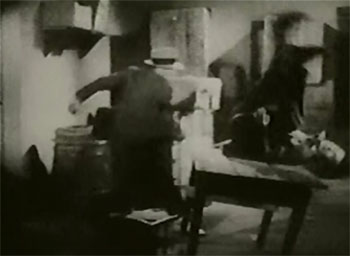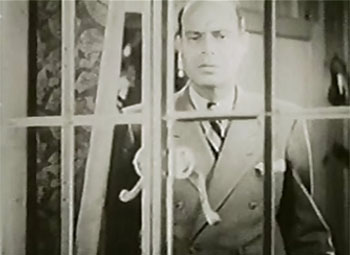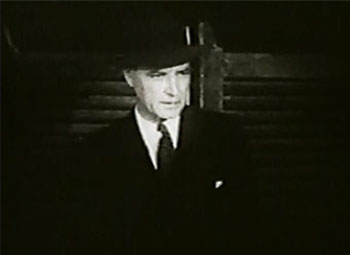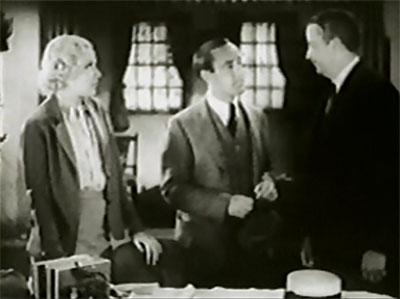
Stage and Screen, 15 Chapters, 1936. Starring Dave O’Brien, Ruth Mix, Robert Walker, Ralph Graves, Robert Frazer, Matthew Betz, Bryant Washburn, Constance Bergen, Snub Pollard.
James Hackett (Robert Frazer), the general manager of the Caswell Shipping Lines, is secretly in league with ruthless criminal Henry Jensen (Matthew Betz)–who, unbeknownst to line owner Frank Caswell (Bryant Washburn), is using Caswell ships to smuggle drugs and other contraband. Jensen is also obsessed with collecting twelve ancient coins that together form a map to an old Spanish treasure-trove; Caswell is on the track of this treasure as well, and has acquired a compilation of papers that contain important information on the coveted coins. Soon, Caswell’s company investigator Terry Navarro (Dave O’Brien) is battling Jensen, Hackett, and their sea-captain accomplice “Shark” Malone (Robert Walker) for these papers and for several of the coins themselves; he receives tacit assistance from undercover government operatives Dorothy Dale (Ruth Mix) and Walter Prescott (Ralph Graves), who are out to smash Jensen’s smuggling ring.
The plot of The Black Coin is surprisingly uncomplicated for a serial produced by Adrian and Louis Weiss–being less overcrowded with characters than that of Custer’s Last Stand, and less convolutedly “mysterious” than that of The Clutching Hand. Due to this comparatively straightforward narrative and some solid action scenes, Coin comes off as fairly fast-moving, despite minimal editing and generally static camerawork. However, it’s far from a rousing success; though its storyline is uncluttered, it’s also exceedingly thin and frustratingly repetitive.
Writers George Merrick (story), Eddie Granemann, Dallas Fitzgerald, Robert Lively, and Al Herman (screenplay; Herman also directs) almost completely abandon Black Coin’s promising drug-smuggling subplot after the first episode, only allowing it to briefly resurface in Chapter Eight; they would have been better off had they used it to provide regular plotting relief from the struggle over the important papers and the black coins. Instead, they focus on this initially interesting struggle so relentlessly that it soon starts to seem tiresomely repetitious; the rapidity with which both papers and coins pass back and forth between the various characters can’t disguise the fact that both characters and narrative are running around in circles. The implausibly coincidental way in which new coins keep popping up also starts to seem unintentionally comic after awhile, since practically everyone that Terry Navarro encounters just happens to have one in their possession–Jensen, Caswell, Malone, an Arab beggar, a Mexican sheep-rancher, and Navarro’s own father (who, taking coincidence a step further, proves to be the direct descendant of one of the sailors who originally hid the treasure).

Above: Three of the Black Coins, whose “history” amusingly proves to be familiar to nearly everyone in the serial.
One keeps expecting these ever-multiplying coins to be gathered together at some point, in order to lead into a hunt for the Spanish treasure–but this anticipated plot turn never comes; the frantic tussle over the coins continues uninterrupted until it’s abruptly terminated in an extremely disappointing final chapter, leaving the audience feeling that all the thefts and pursuits in the preceding episodes have been a big waste of time. Had the investigation of the smuggling ring been given as much prominence as the tussle for the coins, the ending would have seemed decidedly less anticlimactic–since the destruction of the ring would have felt like a hard-won victory; instead, it comes off as a side effect of the coin conflict. The clearing of Caswell (whom the government agents mistakenly suspected of involvement in the smuggling) could also have made the serial’s conclusion more satisfying, but this plotting angle is introduced so belatedly and treated so off-handedly that its fails to have any impact; even Navarro–who not only works for Caswell, but is in love with Caswell’s daughter Virginia–seems completely unperturbed when the finger of suspicion temporarily points towards his employer.

Above: Ralph Graves (standing left) issues a rather strange-sounding last-chapter apology to Bryant Washburn (seated far right), as Ruth Mix (far left), Dave O’Brien, and Constance Bergen watch: “It isn’t customary for government agents to apologize to innocent suspects, but personally in this case I think it’s a little different.” (does that mean it is customary to apologize to guilty suspects?)
The repetitiveness of the ultimately fruitless scramble for the coins is at least somewhat reduced by the way in which the writers keep the characters moving from location to location; the chapterplay’s action begins in Tangiers, moves to America in Chapter Two, spends some time in the city, adjourns to a California fishing village for several episodes, shifts to a Mexican sheep ranch, and later to an American ranch owned by Jensen. Stock footage is judiciously used to assist in depicting some of these locales, but the serial also features a lot of location filming; the hills of Iverson’s Ranch, various rural roads and suburban streets, the beach at Santa Barbara, a full-size boat, and what appears to be an actual airfield are all used to good effect at various points. Most of the interior shots of the fishing village’s bar/dance-room (equipped with a calypso band) seem to be stock footage, but large and surprisingly well-populated hotel sets figure in other sequences.


Above left: Ruth Mix and Ralph Graves gallop across a stretch of sand that, through skillful use of stock footage, convincingly impersonates a North African desert. Above right: A fight aboard Shark Malone’s boat.
As indicated above, Black Coin’s action scenes are a definite notch above the mid-1930s serial norm. Hero Dave O’Brien, an accomplished stuntman, does most of his own fight scenes, and is frequently opposed by equally accomplished stuntman Yakima Canutt (who plays a recurring heavy and doubles others); while pedestrian director Al Herman doesn’t film their repeated encounters with any particular skill, Canutt and O’Brien’s talent for throwing convincing punches and taking believable falls makes the fights seem far more dynamic and exciting than one would expect. Among the most energetic of the clashes involving this duo (and other combatants) are the Chapter Two storeroom fight, the Chapter Six beach fight that continues into Chapter Seven, the shorter-lived fight on the ship in Chapter Ten, and the Chapter Twelve fight in the back of the truck. The horseback chase across the sand dunes that opens the serial, and the foot chase through the Arab town later in Chapter One (a sequence that has O’Brien climbing ropes and dropping off balconies) are standouts too.




Above: Dave O’Brien climbs away from enemies (top left), is knocked across a table (top right), flips Yakima Canutt through the air (bottom left) and takes a good punch from Canutt (bottom right).
Other action highlights include Shark Malone’s fight with his mutinous crew in Chapter Three, the Chapter Thirteen fight in the ranch office, and O’Brien’s spectacular leap from the second story of a hotel later in the same chapter. The latter stunt is followed by a fine car chase, that in turn culminates with a good and rather unique cliffhanger–two cars simultaneously flying off an embankment, instead of the standard single car. Many of the other cliffhangers in Coin are just as strong–particularly the nifty Chapter Twelve ending, which imperils three protagonists at once without seeming contrived: O’Brien and Ralph Graves fight separate antagonists in an out-of-control truck that crashes into Ruth Mix at the fadeout. The Chapter One plane explosion, the Chapter Three plunge off the highway drawbridge and the Chapter Eight jailhouse fire are impressive too; all three are presumably stock footage, but are fitted neatly into the serial. The same cannot be said for the shipwrecks that conclude Chapters Four and Eight; both of them are edited in such chaotic style that the audience completely loses track of the characters who are supposedly being threatened.


Above: The plane explosion cliffhanger (left) and the double car-crash cliffhanger (right).
The actors in Black Coin are given fairly one-dimensional characters, and receive few of the opportunities for dramatics that the players in other Weiss serials enjoyed; most of them play their routine parts well. Dave O’Brien, though third-billed, is definitely the serial’s star, and handles his leading role very capably–making his Terry Navarro seem chipper, confident, authoritative, and toughly determined without ever lapsing into the obnoxiously exaggerated swaggering that marked his later serial-hero turns for director James W. Horne; as aforementioned, he also comes through with flying colors in the action scenes.

Above: Dave O’Brien confronts an off-camera villain.
Weiss regular Ruth Mix (Tom’s daughter) gives her secret-agent character Dorothy Dale an appealing and appropriate combination of enthusiasm and professional self-assurance; she not only provides O’Brien with frequent and well-timed assistance, but does a fair amount of investigating on her own. On the other hand, Ralph Graves (who has top billing but not as much screen time as either O’Brien and Mix) delivers the serial’s worst major performance as Dorothy’s fellow-agent Prescott. A former A-list leading man, Graves appears to have taken an attitude of “I’m only here for the paycheck” towards Coin; he walks through his role in listless, near-somnambulistic style, giving flat and emotionless line readings and almost never varying his mildly solemn facial expression.

Above: Ruth Mix and Ralph Graves prepare to don Arab disguises.
Matthew Betz has little to do but snarl arrogantly and glower grimly as master criminal Jensen, but does that very well, giving the character a hard-bitten and implacable air. Resonant-voiced Robert Frazer is restrainedly and enjoyably hammy as the double-dealing Hackett, continually adopting an urbane but pompously dignified pose to cover his attempts to betray both Caswell and Jensen. Disappointingly, his sneaky double-crosses never lead to any major, plot-altering breach between the villains; the more openly rebellious actions of chief henchman Shark Malone also do little to disturb the storyline’s status quo.


Above left: Matthew Betz. Above right: Robert Frazer.
As the indomitable Malone, former silent star Robert Walker has the serial’s most interesting villainous role–but, while he does a fine of job of conveying self-confidence and quiet toughness, his appearance is too unthreatening and his acting too subdued to make his performance very memorable. A more intimidating or more boisterous actor like Bob Kortman or LeRoy Mason (who played a very similar villain in the later Weiss-Columbia serial Jungle Menace) could have lent a much stronger air of elemental, larger-than-life menace to the role–an air that would have been appropriate to a character who’s referred to by others as a human shark and “the devil’s brother.”
Bryant Washburn and Constance Bergen make a series of token appearances as Caswell and his daughter Virginia, expressing warm approval of O’Brien’s investigations and occasionally getting caught in shipwrecks. Washburn does his usual fine job of portraying a jaunty but dignified man-of-the-world; Bergen is attractive and pleasantly cheerful, although her rather urban-accented voice clashes jarringly with Washburn’s more polished tones at times. Famed silent comedian Snub Pollard plays the Caswell company pilot Vic Moran, and functions as a part-time sidekick to O’Brien, figuring most prominently in the early episodes and the concluding one; his character’s affable bragging and his goggle-eyed pursuit of various girls aren’t particularly funny, but aren’t gratingly obnoxious either.

Above: Constance Bergan watches as Bryant Washburn (far right) issues orders to Snub Pollard.
Reliable heavy Roger Williams is smugly oily as bar proprietor Gleason, a prominent supporting villain; a mellifluous-sounding actor named Pete De Grasse is very good as the ferocious but intelligent Arab smugler Ali Ben Abba, who disappointingly exits the serial early. Richard Cramer swaggers and sneers very entertainingly in a recurring henchman role, backed up by Yakima Canutt as another recurring thug. Blackie Whiteford is Robert Walker’s imposingly gruff first mate, Frank Hagney plays Matthew Betz’s ranch manager, Joe Garcio is a henchman, and Lew Meehan figures prominently in two chapters as a treacherous sheep-ranch foreman.
Inveterate ham Josef Swickard keeps his theatricality within recognizably human limits as Dave O’Brien’s genteel father, while distinguished stage actress Clara Kimball Young is both refined and appealingly kindly as O’Brien’s aunt. John Elliott is somewhat miscast as an elderly Mexican rancher, child actor Jackie Miller plays a young fishing-village inhabitant who helps Ruth Mix, and Lane Chandler is a concerned airport manager. Familar faces Milburn Morante, Al Kikume, Harry Harvey, William Desmond, and Ted Adams pop up (respectively) as another beachfront ally of Mix’s, an Arab henchman, a pilot, a bartender, and a friendly garage proprietor
Good action scenes and an interesting collection of settings keep The Black Coin watchable, but they ultimately can’t compensate for a potentially intriguing plot that devolves into a marathon tug-of-war and finally proves utterly pointless. The lasting impression the serial leaves is one of furious futility; despite its better moments, the poor reputation that it has enjoyed among serial buffs is not exactly undeserved.

Above: Dave O’Brien pole-vaults over an electric fence, in one of the stunt scenes that prevents Black Coin from turning into the complete failure it would otherwise have become.

It is good to see someone else besides me praise the fight scenes in THE BLACK COIN. I thought they were at least two years ahead of how Republic staged their fights.
Republic’s early efforts were surprisingly spotty. I was just rewatching the Fighting Devil Dogs and noted how poor some of the fights were for ’38. I was in martial arts for awhile and we never learned the serial favorite roundhouse inside wrist strike to your opponent’s arms as a technique. I think maybe around ’39 the quality really came in, no small thanks perhaps to Mr Sharpe. Saw this one on TV way too long ago to remember anything. I’ll watch this one again soon to check out the brawls.
The fight scenes were okay, and thank heaven for Dave O’Brien, who kept this one above water, or at least above the worst. Still the uninteresting and convoluted plot simply doesn’t sustain much interest. *1/2 out of *****
I also found The Black Coin dull and boring. The most interesting thing in the serial was the double cliffhanger in chapter seven. While Bryant Washburn and Constance Bergen are trapped aboard a burning ship Dave O’Brien gets caught in a tree that is struck by lightning. Unusual for the writers to use up two good cliffhangers in one chapter.
When you feel the “stock footage” was the best part of the serial – you get the feeling this was a stinker. Slow. O’Brien (with a Latino name), Malone washes up on shore in front of O’Brien’s father’s house, fights are below the standard of the time, a fire in a stateroom sinks a ship (the same ship sank twice), western stock footage, and on and on.
The two winners, however, was when O’Brien went to the floor in a room to avoid gunshots coming through the door. It seemed like a good idea – until you found out there was a back door that he eventually used to escape.
The second prize winner was the lack of finality regarding the coins! Oh, they are lost, and let me give you the 4 coins I have” ends the serial.
I still watched it all and wondered if I liked it when I was 10 years old.
The storyline had many intriguing possibilities, almost none of which the writers seemed interested in pursuing, and a totally disappointing conclusion. It’s an endless back-and-forth involving the papers and the coins, with the shifting locales providing as much confusion as anything of real interest. In between, there were some good action scenes and decent performances, but not much else. Everyone and their brother seemed to know all about the coins anyway, so what’s the point?
I actually enjoyed watching “The Clutching Hand” more than this one, if only because it didn’t offer as much promise at the outset, so the disappointment factor wasn’t as pronounced.